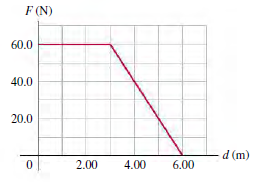You are testing a small flywheel (radius 0.166 m) that will be used to store a small
Question:
(a) You start with a test run to determine the flywheel€™s moment of inertia I. The magnitude F of the force is a constant 25.0 N, and the end of the rope moves 8.35 m in 2.00 s. What is I?
(b) In a second test, the flywheel again starts from rest but the free end of the rope travels 6.00 m; Fig. P10.90 shows the force magnitude F as a function of the distance d that the end of the rope has moved. What is the kinetic energy of the flywheel when d = 6.00 m?
(c) What is the angular speed of the flywheel, in rev/min, when d = 6.00 m?
Figure P10.90

Fantastic news! We've Found the answer you've been seeking!
Step by Step Answer:
Related Book For 

University Physics with Modern Physics
ISBN: 978-0133977981
14th edition
Authors: Hugh D. Young, Roger A. Freedman
Question Posted:





